

Contributor
Summer 2021
Watch our Landscapes of Change video about The Potrero Hill Eco-Patch here.
Preliminary successes and recommendations:
Weed management
Sheet mulching proved to be a highly effective herbicide-free tool for weed management. We would recommend it for anyone wishing to convert a lawn or weedy area to planting. Sheet mulching is a process where you layer compost, cardboard, and wood mulch over the existing ground months in advance of planting. The materials decompose over time, adding organic matter to the soil, and then plants can be planted directly through the mulch into the amended soil. The proportions we used for the Eco-Patch were a half-inch compost layer directly on to the ground, a layer of cardboard with any staples or tape removed, another half-inch of compost, then three inches of wood mulch on top. These quantities were successful for the shrub planting, but the thick layer of wood mulch made planting grass plugs difficult. For grass plugs we recommend using either a thinner layer of wood mulch, removing the mulch before planting, or waiting longer before planting to enable the wood mulch to decompose further.

The weed management category of sheet mulching with the addition of filler seeds was a worthwhile experiment. The plants in the filler category made for beautiful additions to the mixes, however the question of whether they acted to suppress weeds above what the sheet mulching was already accomplishing requires further observations and experimentation.
The solarization method was not successful in the traditional sense. Rather than baking the soil to kill the weed seed, the plastic acted as a greenhouse and encouraged germination. Our hypothesis is that the clear plastic we used, although successful inland, did not generate enough heat in our foggy coastal environment (University of California Integrated Pest Management 2020). If we were to attempt solarization again, we would try with black plastic, which might be more successful. Incidentally, solarization still helped to achieve weed mitigation through “grow and kill.” After a lengthy weeding session to remove the weeds once the plastic was lifted, the solarization plots haven’t experienced any noticeable difference in weed quantities. However, the plots that were sheet mulched have superior soil structure to the solarization plots, likely because of the tillage required as part of the solarization process.
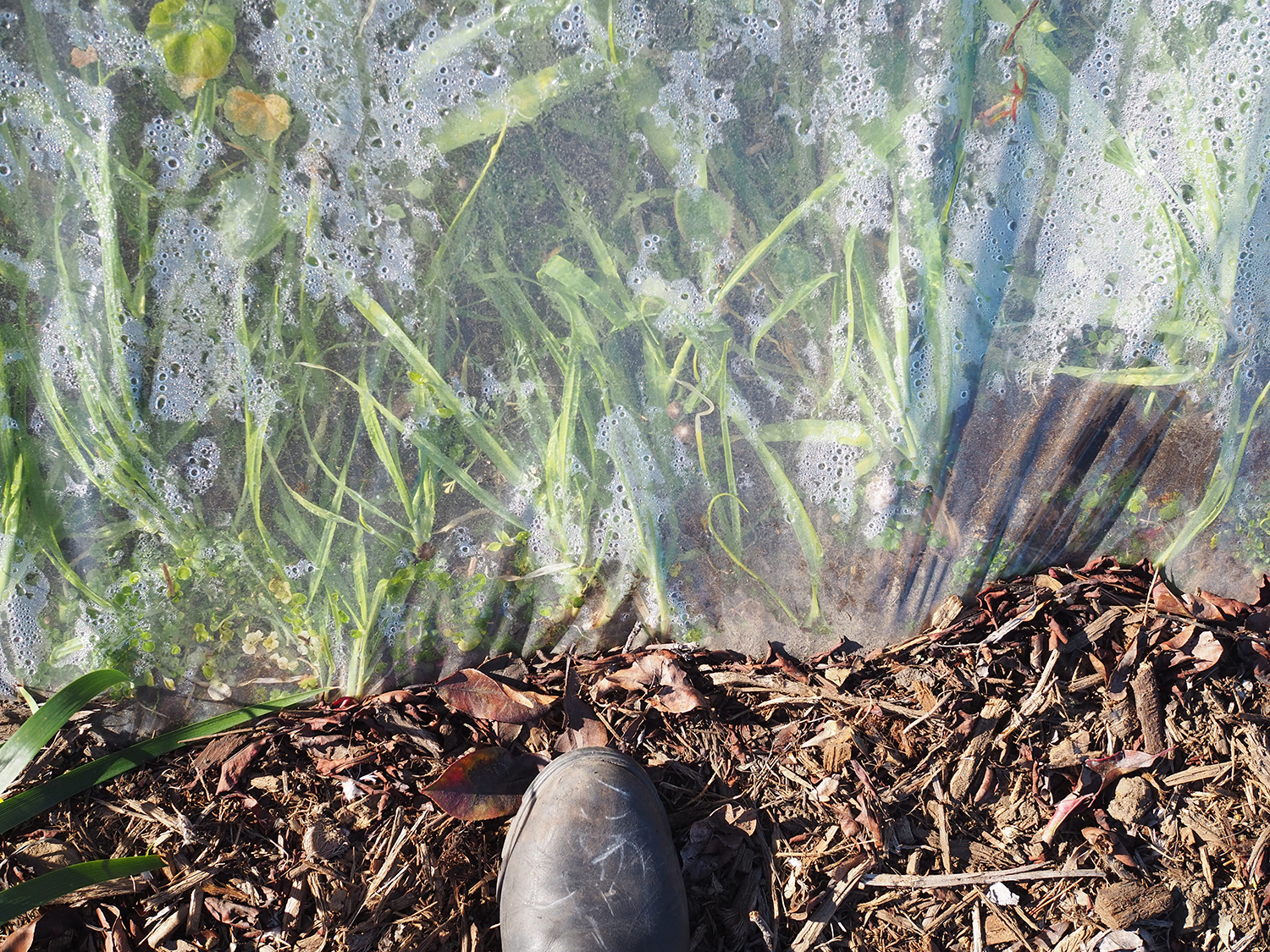
Plant recommendations
While we suggest looking to the wild for inspiration, as we did with our archetypes, we recommend simplifying and limiting the number of plant species to less than you might find in the wild. That way, at a garden scale, repetition in shape, color, and texture can be read clearly.
Sequential blooming
Sequential blooming was a facet of the more successful mixes—both in terms of aesthetics and habitat value. The bloom times we experienced are specific to the location and microclimate of the Eco-Patch but provide a good starting point for developing your own mix.
The timing of the miniature lupine (Lupinus bicolor), manycolored lupine (Lupinus variicolor), dune gilia (Gilia capitata ssp. chamissonis), coyote mint (Monardella villosa) and Ithuriel’s spear (Triteleia laxa) worked well in our “Oak Savanna” mix. We were able to have a long span of staggered bloom times within the matrix of California field sedge (Carex praegracilis), a native rhizomatous grass.
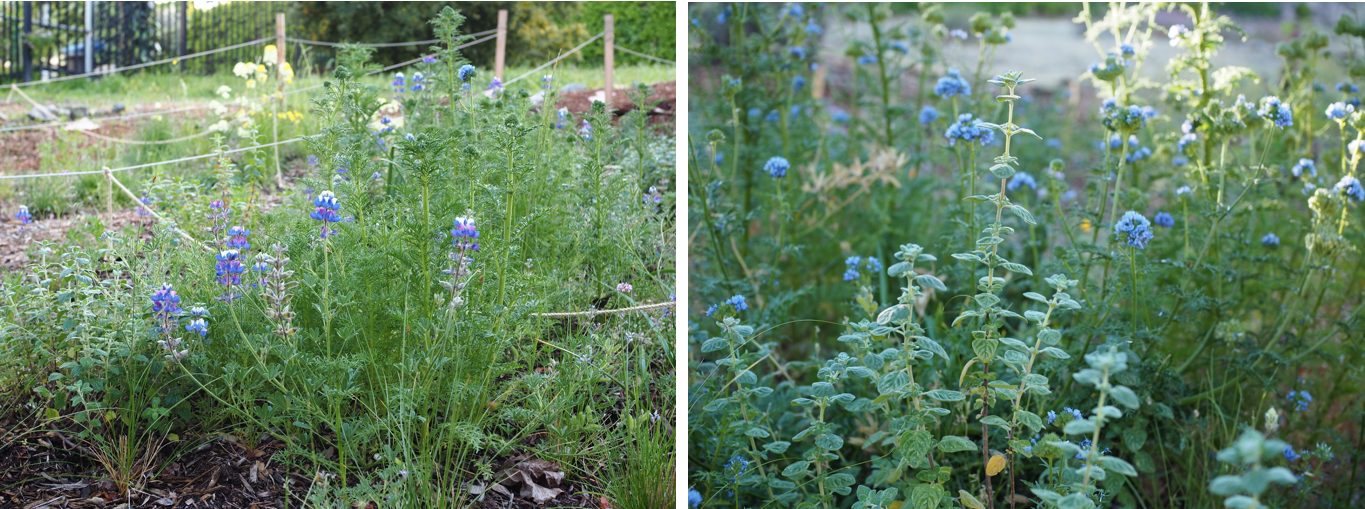
Right: In early May, after the lupines had gone to seed, the dune gilia (Gilia capitata ssp. chamissonis) began to bloom. Its foliage intermingled beautifully with the yet-to-flower coyote mint (Monardella villosa).

Right: The bulb Ithuriel’s spear (Triteleia laxa) bloomed in June after all the other flowers had begun to seed, and the bright blue-purple flowers really pop against the California field sedge (Carex praegracilis) and prairie junegrass (Koeleria macrantha).
Staggered bloom times also worked well in the “Coastal Dune Scrub” mix. The California sea pink (Armeria maritima ssp. californica) and seaside fleabane (Eriogonum glaucus) began blooming in April. By June their flowers were gone but the seaside woolly sunflower (Eriophyllum staechadifolium) had begun to flower. The dried flower heads of the California sea pink persisted and created a perfect foil for the flowering seaside woolly sunflower.

Right: Yellow flowers of the seaside woolly sunflower (Eriophyllum staechadifolium) and foliage of the silver lupine (Lupinus albifrons) in the foreground with the dried flowers of the California sea pink (Armeria maritima ssp. californica) beyond.
It was helpful to observe what plants got the most attention from wildlife throughout the year. We observed the sequence of plants across different mixes that most attracted the native yellow-faced bumblebee (Bombus vosnesenskii). California scorpionweed (Phacelia californica) was an early favorite. As the California scorpionweed began to go to seed, the dune gilia became a popular destination. As the dune gilia started going to seed, the coyote mint got more attention. We encourage gardeners to make those observations about sequencing blooms for wildlife in their own yards, as it will vary based on their location and microclimates.

Right: Coyote mint (Monardella villosa) in June.

Grasses for texture, capturing light, and carbon sequestration
There is a great diversity of native California bunchgrasses. Native California bunchgrasses have extensive fibrous root systems that sequester carbon in the soil (California Native Grasslands Association 2021). While several of the mixes included bunchgrasses for structure and transitions between other plantings, we found that they really stood out in their ability to capture light. Here are some examples of bunch grasses with inflorescences that were able to transform the garden with the way light filtered through them.



Use of evergreen groundcovers
When testing plant mixes, we wanted to find which regionally native plants could provide fast-growing and evergreen groundcovers. The groundcovers were critical to the success of a mix because they help suppress weeds and provide an evergreen foundation as a base for seasonally dormant plants. The best groundcovers are shade tolerant—as they might be shaded by larger and taller plantings—and are ideally rhizomatous so that they spread to fill in any gaps. From our initial observations, beach strawberry (Fragaria chiloensis) and yerba buena (Clinopodium douglasii) were two groundcovers that stood out as particularly promising.
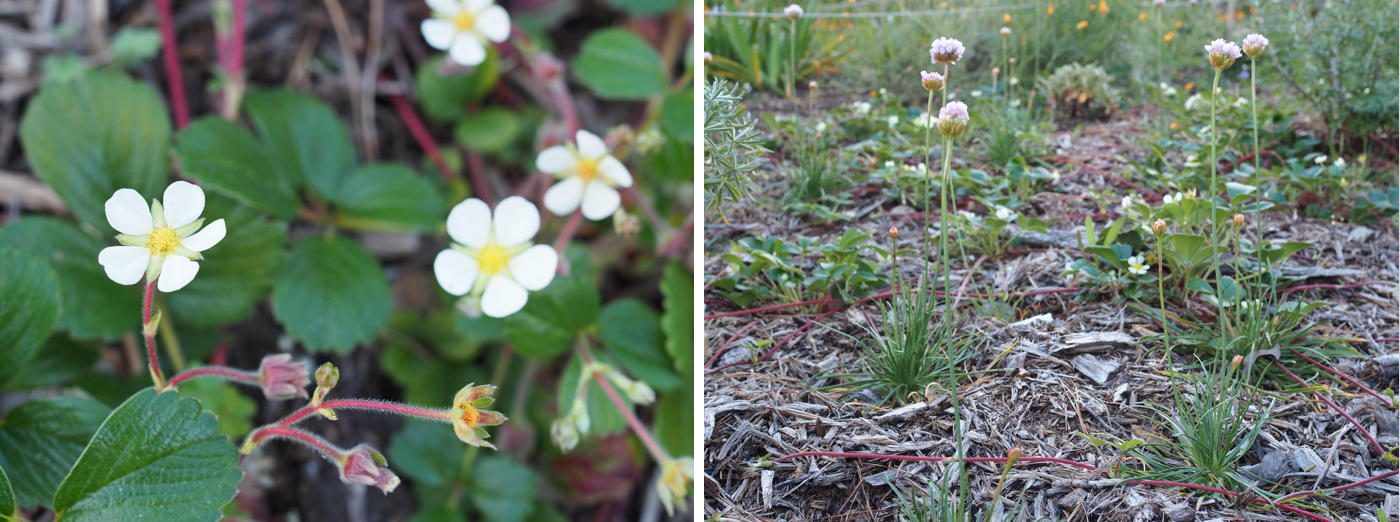
Right: Beach strawberry (Fragaria chiloensis) sending out red runners in between the California sea pink (Armeria maritima ssp. californica) in the “Coastal Dune Scrub” mix. The beach strawberry spread very rapidly.
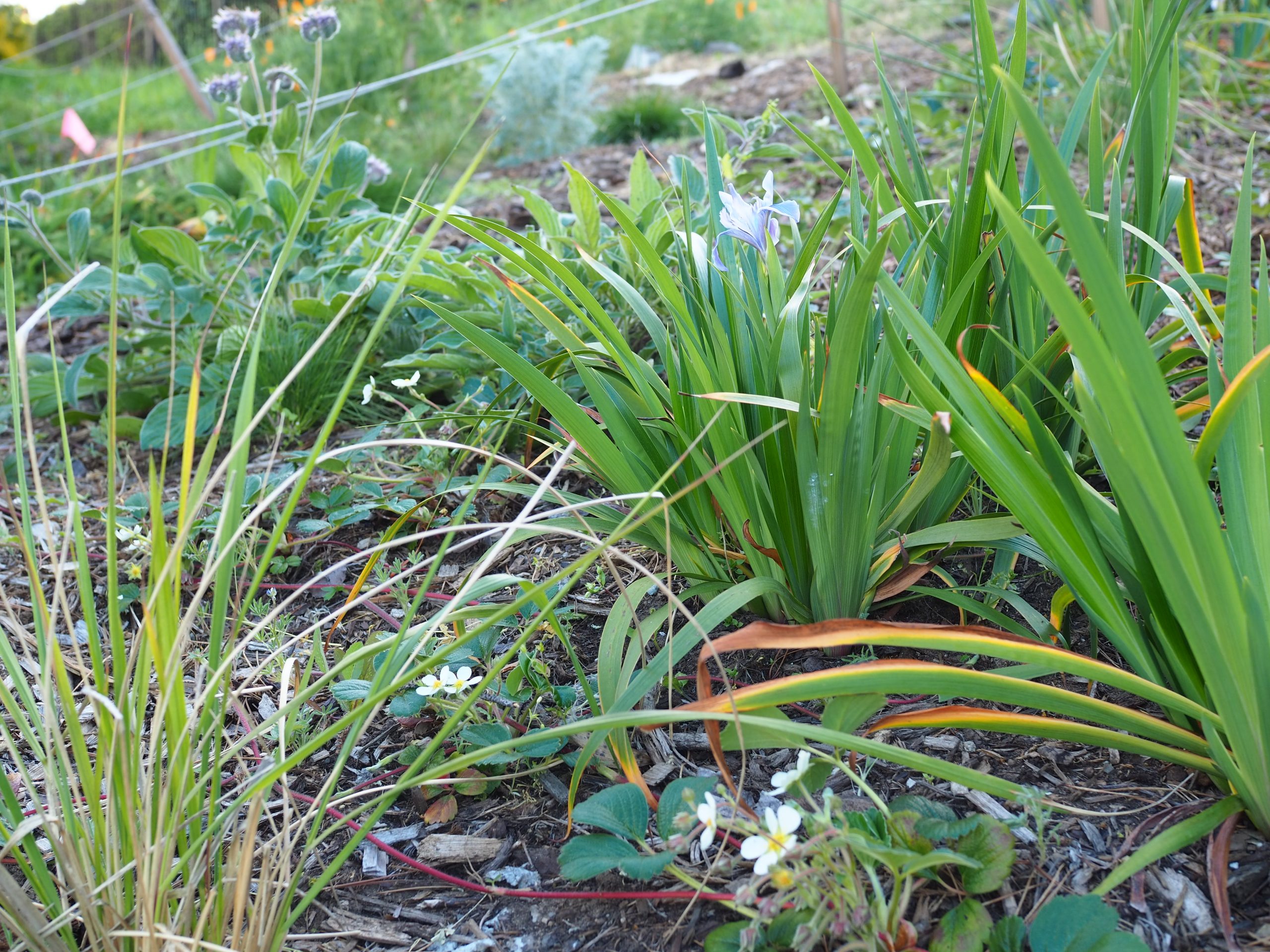
Underutilized native plants
Many native plants that shine during certain parts of the year are inconspicuous at other times. One such plant is the nude buckwheat (Eriogonum nudum), thus named for its sparse foliage. We put it in a mix with shrub-like plants, however upon seeing it flowering, we see that the delicate-looking branching structure and inflorescences would look spectacular emerging from a matrix of grasses. This plant in particular was difficult to source from nurseries but has much potential for habitat and beauty.

Citizen-Power
Our approach focused on engaging the community in design and installation. A sign on the fence welcomes everyone who is interested in joining our efforts. We are certain the long-term success of the garden will depend on community stewardship. Beyond installation and maintenance, we are inviting the community to join us in the process of monitoring and observation using the citizen science app, iNaturalist. iNaturalist allows us to track our own data as well as incorporate others’ observations. Using data collected on iNaturalist, we can monitor the presence of wildlife within a quarter mile of the site. It also allows us to collect neighborhood-specific phenological data about plants that we can use to further fine tune our plant mixes for aesthetics and habitat value. We can take notes about our process and keep track of watering and maintenance efforts using the journaling feature on iNaturalist.
Using iNaturalist as a citizen scientist is just one avenue for citizens to affect change. The simple act of planting natives in a home garden can have a wide reach. Not only does it improve local biodiversity, it also sends the message to nurseries that natives are in demand. More native plant consumers will hopefully translate to more widely available native plants. Additionally, city meetings offer another avenue to advocate for more native planting in public spaces.
Although San Francisco natives have been the primary plants of discussion, residents outside of San Francisco can also become powerful allies in the crusade to improve biodiversity: run an internet search for local native plant demonstration gardens, and your local municipality may have plant lists detailing native plants that are appropriate to your area. For California residents, Calscape is an invaluable tool.

The nursery industry’s role and future research goals
Several of the plants we wanted to test in the Eco-Patch either weren’t available at nurseries or were only available in bulk. We believe there is a professional responsibility for landscape architects to aid local biodiversity wherever possible by including a genetically diverse range of regionally native plant species in projects, yet in our experience many species aren’t readily available. In sourcing plants with local ecotypes for the Eco-Patch, we had to use multiple nurseries, yet in Germany people can buy all the plants from a chosen plant mix as a single product. How could this European model be applied to a California context? We are excited by the CPNS “Bloom! California” campaign that aims to boost the sale of a select range of California native plants in nurseries over the next three years. This is a very encouraging step in the right direction.

We hope to add an additional incentive for people to plant native by researching how regionally native plants can be combined into visually compelling and dynamic mixes through experimentation with plant layers, percentages and spacings. By sharing our findings, we aim to make it easy for gardeners and landscape industry professionals to use plants native to California and for their gardens to look beautiful from a traditional horticultural perspective. Initially, we will continue focusing on garden and sidewalk planting and as we begin working at a larger scale, we would like to experiment with the Swiss and German mixed perennial planting’s streamlined installation approach. In contrast to the modular planting layout we used for the test garden, their layouts are designed so that every plant has the same spacing and the species used is placed at random by the installer—due to extensive testing, this strategy consistently yields a successful result.
Moving forward, we see citizen science as an exciting potential partnership. Once the mixes are developed to a point where they are ready for further widespread testing, home gardeners can become partners in the experiment. For each plant mix home gardeners are trialing, they could log photos and maintenance activities to iNaturalist or a similar app, and help us build a library of data on the mixes in order to refine them and develop others.
We at Field Collective feel energized by the pursuit of mainstreaming ecologically functional native planting within California’s urban and suburban areas. We are encouraged by the growing movement of native plant activists and are optimistic this is the beginning of an ecological and horticultural revolution to improve biodiversity resilience. We are halfway through another challenging drought year, with more difficult years to come as the effects of climate change worsen, yet we remain hopeful. We are inspired by the passionate neighbors of Potrero Hill and overjoyed by the prospect of making a meaningful contribution to the industry and ecosystem.
Resources:
Calscape (run by California Native Plant Society) is an incredibly in-depth database and tool for learning about plants native to California—invaluable for planning native gardens.
Find Eco-Patch on iNaturalist at Potrero Eco-Patch Monitoring Area.
California Department of Fish and Wildlife. 2014. Presidio Manzanita.
California Native Grasslands Association. 2021. Grassland Facts.
California Native Plant Society. 2018 Sheet Mulching.
Davison, V. 2018. Bay Checkerspot Butterfly – Invertebrates, Endangered Species Accounts: Sacramento Fish & Wildlife Office.
Forman, R. T. 1995. Land mosaics: The ecology of landscapes and regions. Cambridge: Cambridge University Press.
Oudolf, P. and Kingsbury, N. 2014. Planting: A new perspective. London, OR: Timber Press.
Rainer, T. and West, C. 2016. Planting in a post-wild world: Designing plant communities that evoke nature. Portland, OR: Timber Press.
Center for Biological Diversity. San Francisco Bay Area and Delta Protection.
Sloan, D. and Karachewski, J. 2006. “Chapter 5 San Francisco: Geology Beneath the Pavement” In Geology of the San Francisco Bay Region. Berkeley: University of California Press.
Tallamy, D. W. 2020. Nature’s Best Hope: a new approach to conservation that starts in your yard. Portland, OR: Timber Press.
University of California Integrated Pest Management. Soil Solarization for Gardens & Landscapes Management Guidelines.
U.S. Fish and Wildlife Service. 2017. Mission Blue Butterfly – Invertebrates, Endangered Species Accounts | Sacramento Fish & Wildlife Office.
Wood, M. 2014. Annotated Checklist of the Vascular Plants of San Francisco’s Natural Areas, 2nd ed.
Nurseries we worked with for our project:
Share:
Social Media
Garden Futurist Podcast
Most Popular
Videos
Topics
Related Posts

Design Futurist Award Announced: Committee Shares Vision
March 8, 2023 At Pacific Horticulture, we believe that beauty can be defined not only by gorgeous plants and design, but also by how gardens

Native Bees and Your Garden
Winter/Spring 2023 The native bees in and around our gardens face ever-increasing environmental pressures as they carry out their pollination duties. More than a quarter
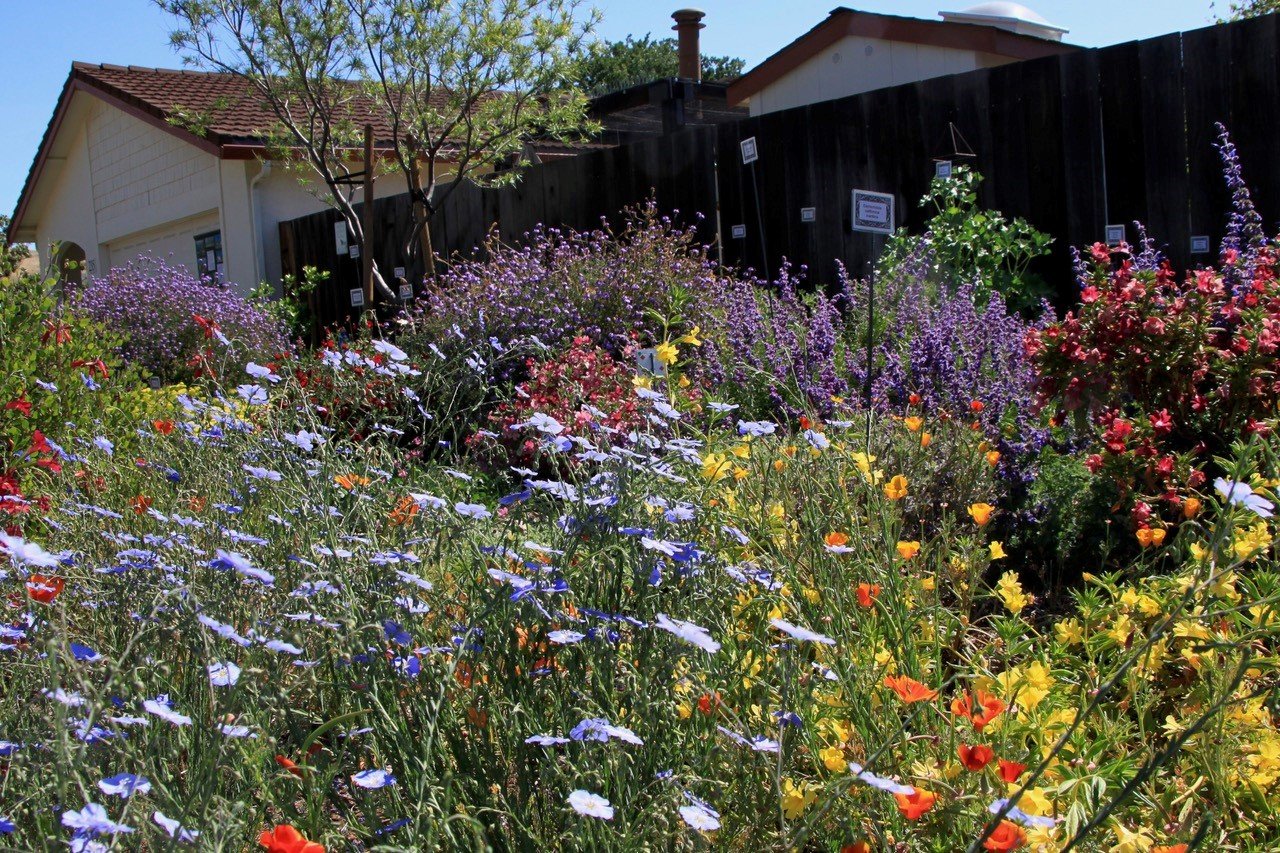
Voices of the West; New Science on Life in the Garden
Did you know that oaks can harbor over 800 species of insects? That includes only those feeding directly on oak, where they feed on every

Expand Your Palette: Waterwise Plants for your Landscape
There’s nothing more thrilling to plant lovers than discovering new plants to test in the garden. Here in the southernmost corner of California, we have









Responses